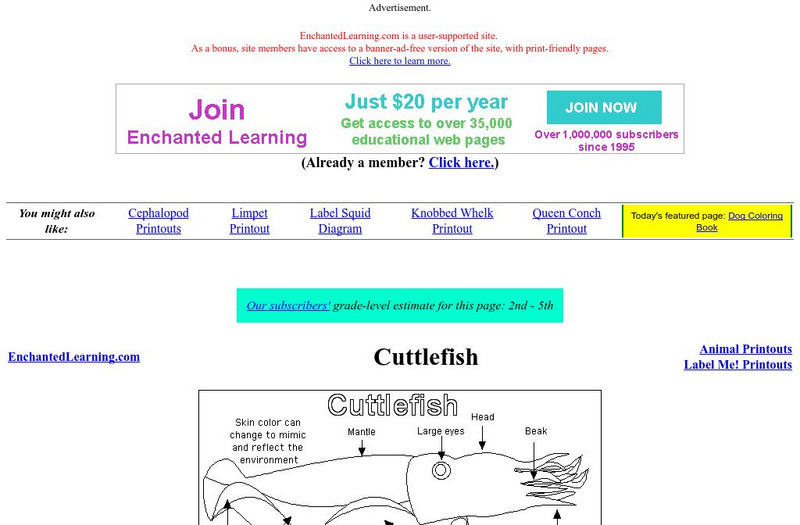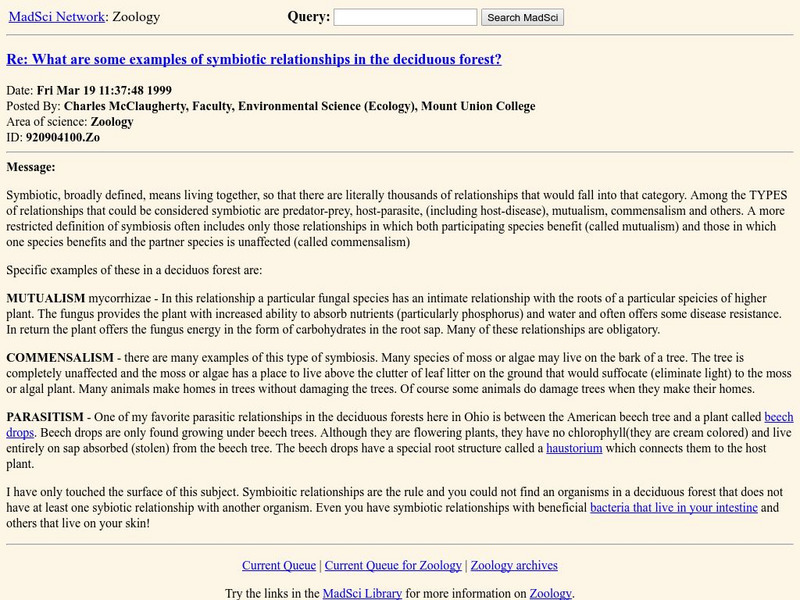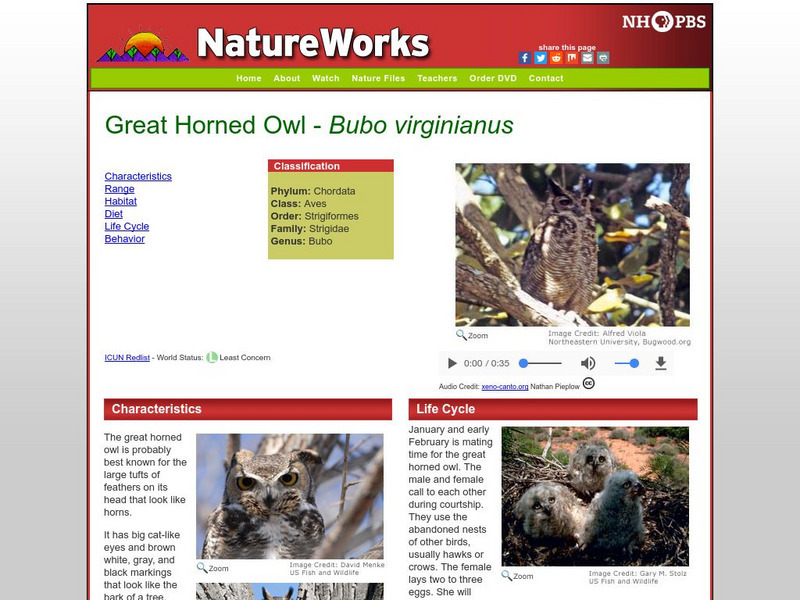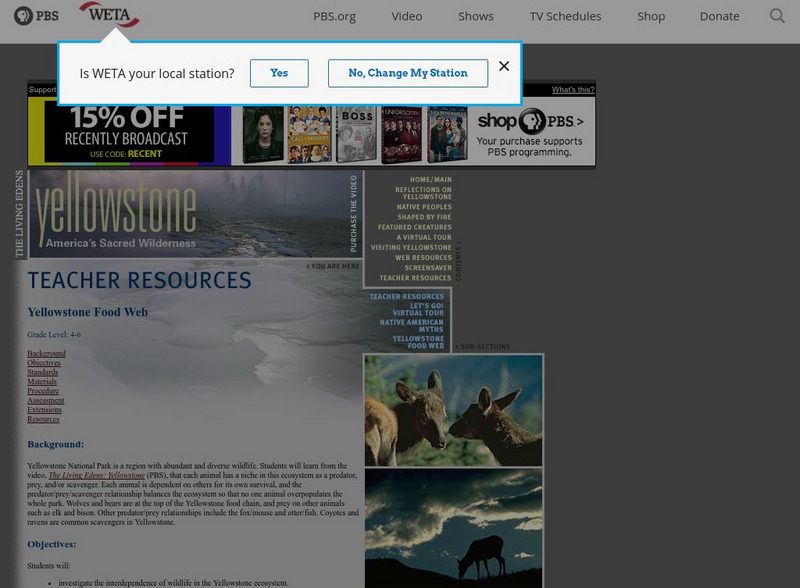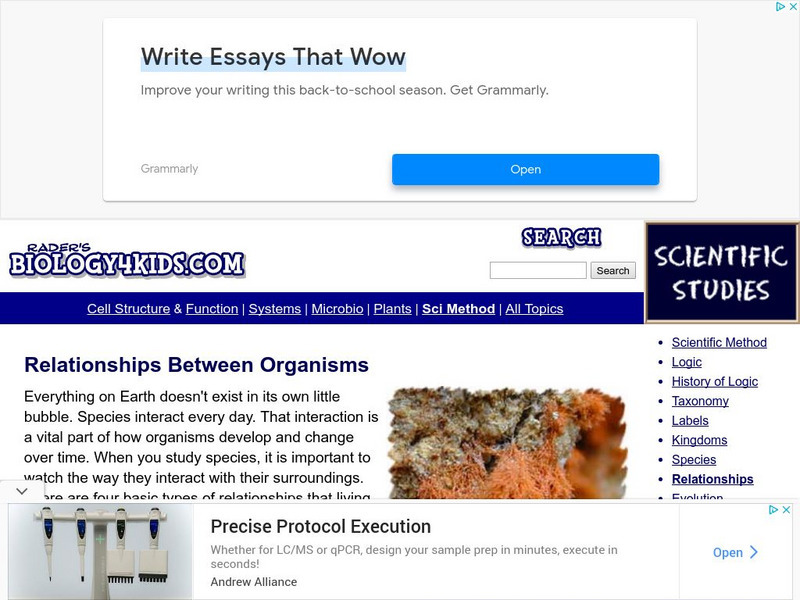Smithsonian Institution
Smithsonian National Zoo: Chambered Nautilus
As part of the Invertebrates exhibit at the National Zoo, this site highlights various facts and interesting information on Chambered Nautilus. Topics covered in the overview include Physical description, Life span, Predators,...
Enchanted Learning
Enchanted Learning: Cuttlefish
Explore the world of the cuttlefish, a unique cephalopod. Students will gain a greater understanding of this mollusk through fun facts, information on the anatomy, diet, predators and more at this site.
Australian Museum
Australian Museum: Dinosaurs on the Attack
Scientists have theropods overcame their prey using their claws and teeth are described.
A-Z Animals
A Z Animals: Animal Facts: Snowy Owl (Bubo Scandiacus)
Provides photographs and a fact card about the snowy owl. Discusses where they are found, physical characteristics, range of travel, nesting behavior, reproduction, diet and feeding, and predators.
Science Buddies
Science Buddies: Predators and Prey: How Do Cats Respond to Bird Sound
A science fair project that ask whether cats respond to familiar bird sounds more readily that bird sounds in general. The Science Buddies project ideas are set up consistently beginning with an abstract, objective, and introduction,...
BSCS Science Learning
Bscs: Frog Eat Frog World
Using maps and graphs of large data sets collected in FrogWatch, middle schoolers will determine the range, preferred land cover, and proximity to water of the American bullfrog to figure out the bullfrog's requirements for food, water,...
Other
Biology at Shaw High School: What Do Living Things Need to Survive?
Discusses the interrelatedness of all living things and of ecosystems and biomes, and what organisms need to survive and to maximize the carrying capacity of an ecosystem. This explanation is followed by a series of activities including...
MadSci Network
Symbiotic Relationships in the Deciduous Forest
A brief definition of symbiotic, followed by explanations of mutualism, commensalism, and parasitism.
Science Struck
Science Struck: Symbiotic Relationships in the Deciduous Forest
Explains what a symbiotic relationship is, the five main types of symbiosis, and provides examples of symbiotic relationships among living things in a deciduous forest.
CK-12 Foundation
Ck 12: Life Science: 112.16 Producer
Understand the role that producers play in the ecosystem.
Curated OER
Promachus Sp. [Skaife Et Al. 1981]
You can download a database made by Dr. Robert LaVinge. The database will give you almost every predator prey relationship.
PBS
Nh Pbs: Nature Works: The Great Horned Owl
Explore the world of the great horned owl through this clear and concise site. This resource features information on the characteristics, habitat, food, reproduction and more of the great horned owl.
PBS
Pbs Teachers:yellowstone: Yellowstone Food Web
Investigate the interdependence of wildlife in the Yellowstone ecosystem and draw an ecosystem showing the interdependence of life forms.
University of Texas at Austin
Univ. Of Texas: Texas Memorial Museum: Creating a Freshwater Ecosystem [Pdf]
An activity where students create a mobile that represent a freshwater ecosystem that appears in nature. Requires Adobe Reader [PDF].
Other
Zephyrus: Food Puzzle Chain
Answer these ten interactive questions about ecological feeding relationships by choosing the correct image that completes each food chain.
PBS
Pbs Kids: Plum Landing: Fence for a Fox
This PBS Kids activity is an extension of a Plum Landing episode featuring foxes in Australia. Students will learn basic information about these foxes. Students will also design a fence to protect chickens from these nonindigenous foxes.
PBS
Pbs Kids: Plum Landing: Link to the Lynx
This PBS Kids activity is an extension of a Plum Landing episode featuring the lynx. Students will learn basic information about the lynx; students will also use online drawing tools to design a scene with a lynx hunting for food.
Project Britain
Primary Homework Help: Food Chains Quiz
Brush up on food chain vocabulary before taking this interactive quiz. Check the box for the correct answers throughout the assessment.
Alabama Learning Exchange
Alex: Nocturnal Animals Lesson #4: Owls
During this activity, students will visit various Internet sites to learn facts about owls. They will use this information to draw a picture of the owl food chain, dissect owl pellets, and write a poem about owls.
Science Education Resource Center at Carleton College
Serc: Mn Step: The Flow of Energy: Balancing Ecosystems
A lesson outlining activities for a science unit where students can learn about the relationships and the flow of energy within an ecosystem. These include predator and prey, hosts and parasites, and consumers, producers, and decomposers.
PBS
Nh Pbs: Nature Works: Bony Fish
This site identifies different characteristics and information related to Bony Fish. Find out some fun facts about these friendly fish when you explore this site.
Biology 4 kids
Biology4 Kids: Relationships Between Organisms
Species interact every day. That interaction is a vital part of how organisms develop and change over time. When you study species, it is important to watch the way they interact with their surroundings. There are four basic types of...
Pittsburgh Zoo & PPG Aquarium
Pittsburgh Zoo: Barn Owl
Barn owls are sometimes called "monkey owls" in reference to their peculiar white, heart-shaped face. Use this resource to discover other unique facts about these silent predators.
SRI International
Performance Assessment Links in Science: Follow Those Tracks
This lesson plan requires students to make an inference (hypothesis) about two animals based on the tracks they leave behind. Students are asked to write a story explaining their inference.
Other popular searches
- Predator Prey Graph
- Predator Prey Relationships
- Predator Prey Game
- Predator Prey Parasite Host
- Predator Prey Population
- Predator and Prey Activities
- Predator Prey Cycles
- Predator and Prey Science
- Predator Prey Interactions
- Predator Prey Relationships
- Predator Prey Simulations
- Predator and Prey Balance

